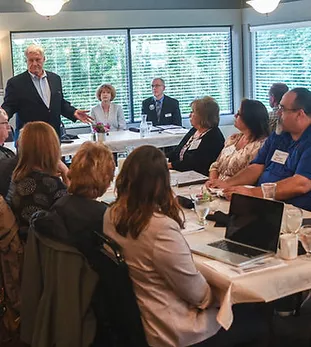West Central Tribune / Carolyn Lange
WILLMAR — With a number of regional highway projects — like U.S. Highway 71 north of Willmar — just finishing up, and funding approved for the state Highway 23 four-lane project between Willmar and St. Cloud, transportation officials say there’s much to be thankful for.
“But there are ongoing needs,” said Margaret Donahoe, executive director of the Minnesota Transportation Alliance, during a meeting Thursday in Willmar that was held to highlight transportation issues with legislators and candidates prior to the Nov. 6 election.
“We want to make sure candidates understand how important transportation funding is and that they talk about how to deal with this problem before the 2019 legislative session,” she said.

Representatives from the Minnesota Department of Transportation, the city of Willmar, Kandiyohi County, the Willmar Lakes Area Chamber of Commerce, the Highway 23 Coalition and three regional transit systems representing more than 15 counties all spoke about the need for additional funding to create a solid transportation infrastructure and a transit service that effectively serves greater Minnesota.
“There was a lot of talk about the economic impact of transportation in this part of the state and how important it is to area businesses,” said Donahoe, in comments made after the forum.
There was also a lot of talk about huge gaps in how much money is needed — and how much money is available — to maintain and improve transportation infrastructure and transit programs.
“Everything always falls back to money,” said Craig Rempp, president of the Minnesota Public Transit Association. “We need dependable funding sources.”
Area transit systems have been hurt by the interpretation of a tax law: Volunteer drivers who receive a stipend for using their own vehicles and time to take senior citizens to medical appointments now have to pay taxes on that stipend.
As a result, the number of volunteer drivers has dropped significantly because of the tax implications, said Tiffany Collins, transit director of Central Community Transit, which serves Kandiyohi, Meeker and Renville counties.
MnDOT estimates it needs $39 billion to meet its 20-year goals, but the current revenue stream generates $21 billion.
“There’s a gap,” said Lindsey Bruer, planning director for the MnDOT District 8 office in Willmar.
Without additional funding, the condition of the state’s roads and bridges will decline over the next 20 years. “The need for funding is real,” she said.
On the positive side, thanks to the state’s Corridors of Commerce funding, work is beginning on the project to complete gaps in the four-lane on Highway 23 between Paynesville and Richmond, said Susan Karnowski, MnDOT assistant district engineer. “That’s big news around here,” she said.
The Highway 23 four-lane bypass around Paynesville was one of the last projects to get federal funding with the help of bipartisan earmarks, said Ken Warner, president of the Willmar Lakes Area Chamber of Commerce.
U.S. Rep. Collin Peterson, who attended the meeting, said he was not happy when transportation earmarks — which dedicated money for specific projects in a representative’s specific district — went away.
“I was against getting rid of them,” said Peterson. “Nobody knows districts better than representatives.”
Peterson said earmarks is a “dirty word,” but he predicts they may make a return to congressional funding packages, but with a different name. He also said the federal gas tax has not increased since 1992 and it needs to be raised to fund more transportation projects.
Peterson praised local groups for making repeated treks to Washington, D.C., to ask for federal funding for local transportation projects.
“The trips you’ve made to D.C. are important. Keep doing it,” he said. “The squeaky wheel gets the grease.”
